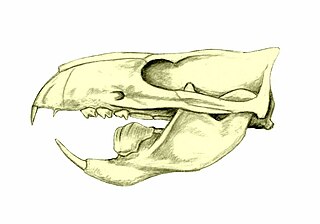
Ptilodus is a genus of mammals from the extinct order of Multituberculata, and lived during the Paleocene in North America.

Cimolodonta is a clade of multituberculate mammals that lived from the Cretaceous to the Eocene. They probably lived something of a rodent-like existence until their ecological niche was assumed by true rodents. The more basal multituberculates are found in a different suborder, "Plagiaulacida", a paraphyletic group containing all non cimolodontan multituberculates.

Cimexomys is an extinct North American mammal that lived from the Upper Cretaceous to the Paleocene. For a while, it shared the world with dinosaurs, but outlived them. It was a member of the extinct order Multituberculata and lies within the suborder Cimolodonta. It is perhaps a member of the Paracimexomys group, though it is not certain.
Mimetodon is a small mammal from the Paleocene of North America and perhaps Europe. It was a member of the extinct order Multituberculata within the suborder Cimolodonta and family Neoplagiaulacidae.
Parectypodus is an extinct genus of mammals that lived from Late Cretaceous (Maastrichtian) to Eocene time in North America. It is a member of the extinct order of Multituberculata, suborder Cimolodonta, family Neoplagiaulacidae. It was named by G.L. Jepsen in 1930.
Stygimys is an extinct mammal genus from the Upper Cretaceous and Paleocene of North America. It was a member of the extinct order Multituberculata within the suborder Cimolodonta, family Eucosmodontidae.
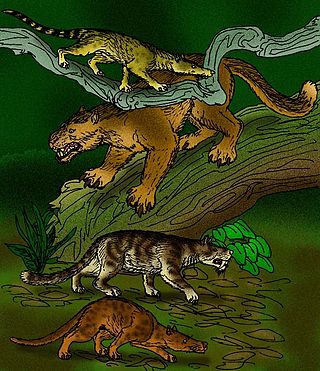
Creodonta is a former order of extinct carnivorous placental mammals that lived from the early Paleocene to the late Miocene epochs in North America, Europe, Asia and Africa. Originally thought to be a single group of animals ancestral to the modern Carnivora, this order is now usually considered a polyphyletic assemblage of two different groups, the oxyaenids and the hyaenodonts, not a natural group. Oxyaenids are first known from the Palaeocene of North America, while hyaenodonts hail from the Palaeocene of Africa.
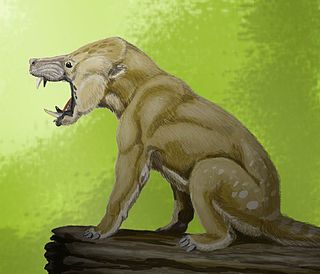
Condylarthra is an informal group – previously considered an order – of extinct placental mammals, known primarily from the Paleocene and Eocene epochs. They are considered early, primitive ungulates and is now largely considered to be a wastebasket taxon, having served as a dumping ground for classifying ungulates which had not been clearly established as part of either Perissodactyla or Artiodactyla, being composed thus of several unrelated lineages.
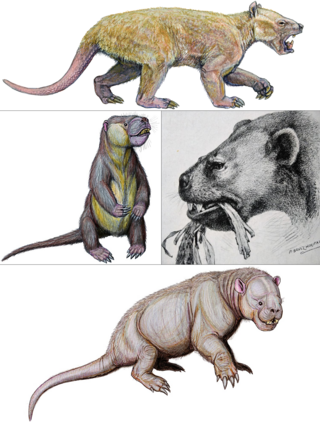
Taeniodonta is an extinct order of eutherian mammals, that lived in North America and Europe from the late Cretaceous (Maastrichtian) to the middle Eocene.
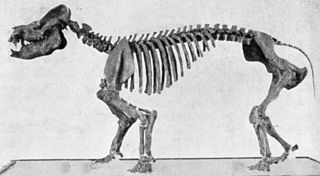
Coryphodon is an extinct genus of pantodonts of the family Coryphodontidae.

Arctocyon is an extinct genus of ungulate mammals. Arctocyon was a "ground dwelling omnivore", that lived from 61.3-56.8 Ma. Synonyms of Arctocyon include Claenodon, and Neoclaenodon. Arctocyon was likely plantigrade, meaning that it walked with its feet flat on the ground, rather than on its toes.

Protungulatum is an extinct genus of eutherian mammals within extinct family Protungulatidae, and is possibly one of the earliest known placental mammals in the fossil record, that lived in North America from the Late Cretaceous to early Paleocene.

Mesonychidae is an extinct family of small to large-sized omnivorous-carnivorous mammals. They were endemic to North America and Eurasia during the Early Paleocene to the Early Oligocene, and were the earliest group of large carnivorous mammals in Asia. Once considered a sister-taxon to artiodactyls, recent evidence now suggests no close connection to any living mammal. Mesonychid taxonomy has long been disputed and they have captured popular imagination as "wolves on hooves", animals that combine features of both ungulates and carnivores. Skulls and teeth have similar features to early whales, and the family was long thought to be the ancestors of cetaceans. Recent fossil discoveries have overturned this idea; the consensus is that whales are highly derived artiodactyls. Some researchers now consider the family a sister group either to whales or to artiodactyls, close relatives rather than direct ancestors. Other studies define Mesonychia as basal to all ungulates, occupying a position between Perissodactyla and Ferae. In this case, the resemblances to early whales would be due to convergent evolution among ungulate-like herbivores that developed adaptations related to hunting or eating meat.

Arctocyonidae is an extinct, possibly polyphyletic family of placental mammals which lived from the late Cretaceous to the early Eocene. They were initially regarded as creodonts, though have since been reassigned to an order of their own, the Arctocyonia. Some have suggested that arctocyonids are ancestral to modern-day artiodactyls, or that they form a sister group. However, more recent phylogenetic analyses suggest that arctocyonids may represent an artificial grouping of extinct ungulates, or that they might be an assemblage of unrelated placentals related to pangolins, pantodonts, and periptychids.

Tillodontia is an extinct suborder of eutherian mammals known from the Early Paleocene to Late Eocene of China, the Late Paleocene to Middle Eocene of North America where they display their maximum species diversity, the Middle Eocene of Pakistan, and the Early Eocene of Europe. Leaving no descendants, they are most closely related to the pantodonts, another extinct group. The tillodonts were medium- to large-sized animals that probably fed on roots and tubers in temperate to subtropical habitats.

Phenacodontidae is an extinct family of large herbivorous mammals traditionally placed in the “wastebasket taxon” Condylarthra, which may instead represent early-stage perissodactyls. They lived from the late early Paleocene to early middle Eocene and their fossil remains have been found in North America and Europe. The only unequivocal Asian phenacodontid is Lophocion asiaticus.

Triisodon is a genus of extinct mesonychian mammal that existed during the Early Paleocene of New Mexico, North America, from about 63.5-62.0 Ma. The genus was named by Edward Drinker Cope in 1881 as a member of the Acreodi, a now invalid taxon that encompassed creodonts, mesonychians and certain arctocyonians. Cope described the type specimen of T. quivirensis as "about the size of a wolf." A smaller species, T. crassicuspis, has also been identified from the same region. Since material from this genus is incomplete, the exact size of adults and whether they showed sexual dimorphism or regional variations in size is unknown.
Anacodon is a genus of arctocyonid from the Eocene of North America. It is known from the type species, A. ursidens, a second species, A. cultridens, and a possible third, A. nexus. Initially believed to be a relative of Phenacodon, it was subsequently found to be an arctocyonid, possibly related to Claenodon. Anacodon was extremely robust compared to other members of its family, and may have been capable of climbing and digging like modern bears.
Loxolophus is a genus of large arctocyonid from the early Palaeocene of North America. Two species are currently recognised: the type species, Loxolophus hyattianus, and L. priscus.











